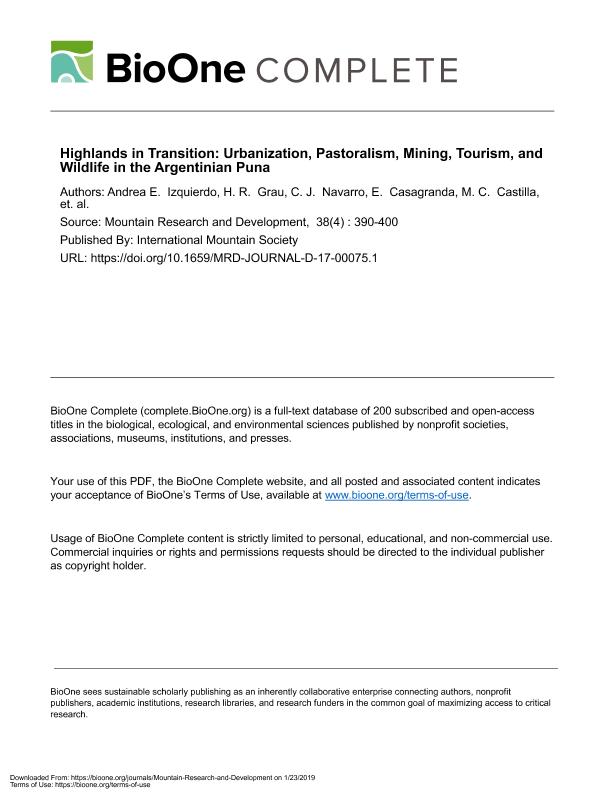Artículo
Highlands in transition: Urbanization, pastoralism, mining, tourism, and wildlife in the Argentinian Puna
Izquierdo, Andrea Elisa ; Grau, Hector Ricardo
; Grau, Hector Ricardo ; Navarro, Carlos Javier
; Navarro, Carlos Javier ; Casagranda, Maria Elvira
; Casagranda, Maria Elvira ; Castilla, María Cecilia
; Castilla, María Cecilia ; Grau, Alfredo
; Grau, Alfredo
 ; Grau, Hector Ricardo
; Grau, Hector Ricardo ; Navarro, Carlos Javier
; Navarro, Carlos Javier ; Casagranda, Maria Elvira
; Casagranda, Maria Elvira ; Castilla, María Cecilia
; Castilla, María Cecilia ; Grau, Alfredo
; Grau, Alfredo
Fecha de publicación:
11/2018
Editorial:
Mountain Research & Development
Revista:
Mountain Research And Development
ISSN:
1994-7151
Idioma:
Inglés
Tipo de recurso:
Artículo publicado
Clasificación temática:
Resumen
Land use change is a key component of regional environmental change. In mountain regions, where conditions for agriculture and human life are often difficult, land use trends are dominated by changes in the population's distribution across rural and urban areas and shifts in the main human activities. In the Argentinian puna- A high-elevation subtropical plateau of about 95,000 km situated above 3200 masl-land is chiefly used for grazing, mining, and tourism. In this article, we analyze trends in these land uses over the last 57 years in the context of climatic changes toward drier and warmer conditions. Since 1960, the human population grew from 80,000 to 130,000; but this increase largely occurred in the scattered urban centers, while the rural population decreased. The main livestock-sheep-showed a net decrease of around 100,000 animals (-18.5%), with numbers increasing between 1960 and 1980 and then dropping markedly. The number of mining operations declined during the 1970s and 1980s and then rose sharply, reaching a 30% increase since the 1990s. Simultaneously, structural wild vicunã populations increased from a few thousand to around 130,000. These results show that environmental changes over the past half century involved a major wildlife recovery associated with a change from widespread extensive grazing to intensive but spatially limited impacts around mining operations and growing urban centers. Tourism emerged as a new activity over the last decades, but the environmental impacts have been poorly studied. To promote local development and regional conservation, research priorities should include (1) empirical assessments of the ecological consequences of land use changes, such as grazing regimes shifting from domestic to wild herbivores, as well as the impacts of mining, tourism, and urbanization on wetlands and hydrological regimes; (2) modeling of future scenarios of mining and tourism expansion and resulting conflicts with environmental conservation; and (3) coproduction of knowledge about interactions among land uses, climate change, and the different decision-making agents.
Palabras clave:
GRAZING
,
HERBIVORY TRANSITION
,
LAND USE TRANSITION
,
MINING
,
PUNA
,
TOURISM
,
URBANIZATION
Archivos asociados
Licencia
Identificadores
Colecciones
Articulos(IER)
Articulos de INSTITUTO DE ECOLOGIA REGIONAL
Articulos de INSTITUTO DE ECOLOGIA REGIONAL
Articulos(SEDE CENTRAL)
Articulos de SEDE CENTRAL
Articulos de SEDE CENTRAL
Citación
Izquierdo, Andrea Elisa; Grau, Hector Ricardo; Navarro, Carlos Javier; Casagranda, Maria Elvira; Castilla, María Cecilia; et al.; Highlands in transition: Urbanization, pastoralism, mining, tourism, and wildlife in the Argentinian Puna; Mountain Research & Development; Mountain Research And Development; 38; 4; 11-2018; 390-400
Compartir
Altmétricas



